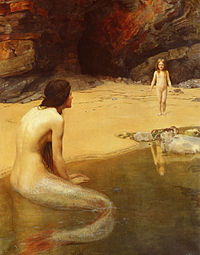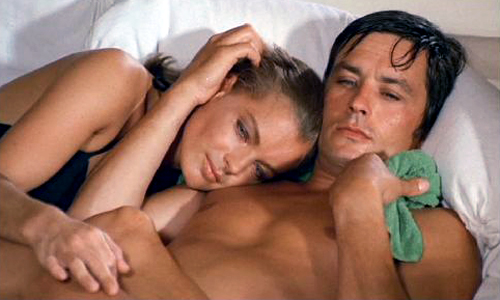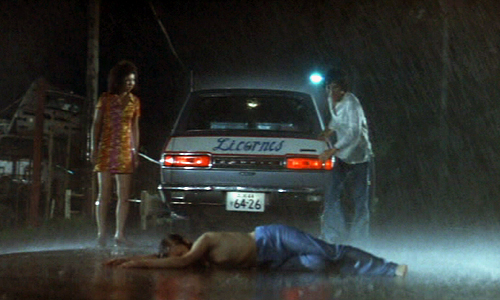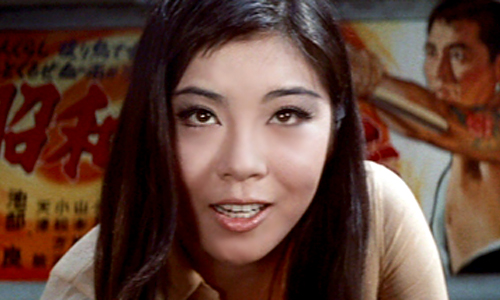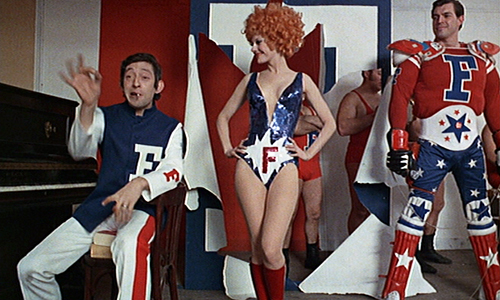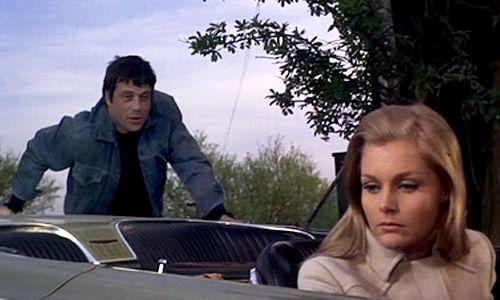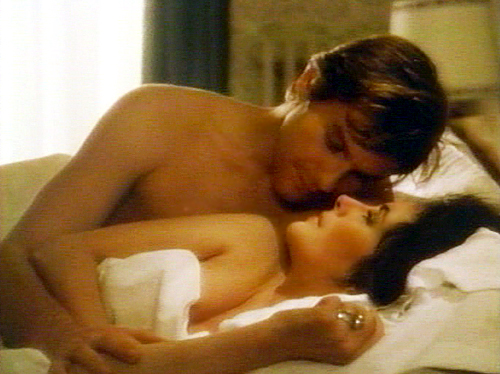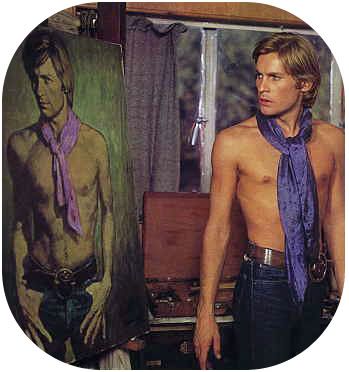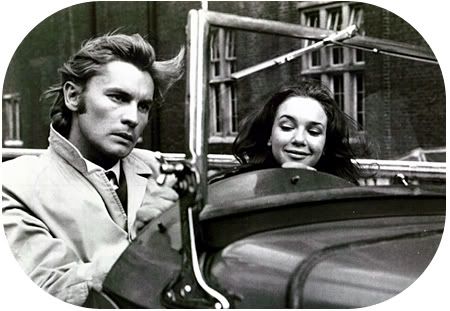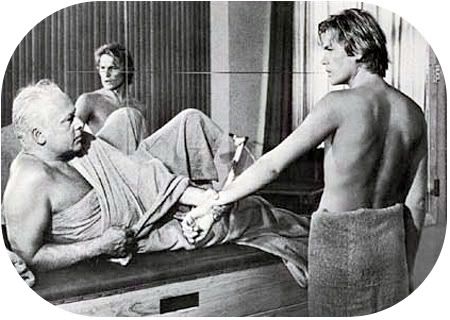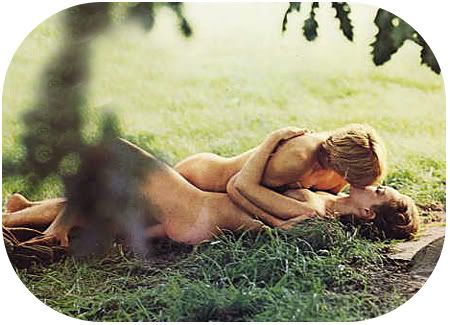by Cristina Neri | March 11, 2009
I hate to be the bearer of bad news, but overall 2008
was somewha of a lackluster year for new Region 1 DVD
releases of ’60s and ’70s era films when compared to
the previous two years (See: 2006&2007).
Some of my favorite DVD companies such as BCI Eclipse
and most recently New Yorker Films have folded.
Boutique DVD companies are releasing fewer products
and what is being released is often of questionable
quality. With the failing economy and the rise in
popularity of Blu-ray discs, it seems like the number
of new worthwhile DVD releases might continue to drop
dramatically in 2009.
Many companies such as Blue Underground and Criterion
are choosing to re-release films that have already
been available on DVD, while big studios like Warner
Brothers and Paramount seem to be focusing a lot of
their energy on re-releasing titles on Blu-ray instead
of releasing old films from their vaults.
Even with this disappointing turn of events, fans of
’60s and ’70s cinema were still offered some great DVD
box sets from companies like Lions Gate as well as
Criterion. Sony Pictures has also released an interesting
batch of DVDs under their new "Martini Movies" label.
And with curiosity about Japanese pink films on the
rise, companies like Mondo Macabro and Media Blasters
took full advantage of this and released some unexpected
gems last year. 2008 was also a great year for British
horror fans. Besides multiple Hammer DVD releases
including the Icons of Horror: Hammer Films Collection
and the Icons of Adventure Film Collection, there were
also some great Amicus films released such as Freddie
Francis’ The Skull and The Deadly Bees. In previous
years I’ve shared a list of my Top 30 Favorite DVD
releases, but this year I’m narrowing my list down to
my favorite Top 20 releases.
This is mainly due to my disappointment with last
year’s DVD offerings and I wanted to focus on a limited
selection of new releases that I really enjoyed.
As always, my list only features films that were originally
released between 1960 and 1979 on Region 1 DVD. I tried
not to include any DVD re-releases on my list or TV shows,
but there were plenty to choose from. My selections are
listed in alphabetical order and I’ll be posting them
in two parts in the coming week.
Alain Delon and Romy Schneider in La Piscine (1969)
1.Alain Delon - Five Film Collection (Lions Gate)
Anytime an Alain Delon film finds it’s way onto DVD
for the first time there’s a celebration in my home!
The Lions Gate Alain Delon DVD boxset was a real treat
and offered viewers the opportunity to see five films
starring my favorite French actor. I thought the best
films in the collection were easily La Piscine aka
The Swimming Pool (1969) and Diaboliquement vôtre
aka Diabolically Yours (1967), which I reviewed back
in 2007. But The Widow Couderc and Notre Histoire
also make for some worthwhile viewing. Le Gitan aka
The Gypsy (1975) is a bit like sitting through
Zorro II, but it’s missing the catchy theme song.
I actually enjoy Delon’s original Zorro (1975) film,
but Le Gitan left me a little cold. For more
information about this DVD release please see my
previous comments about it here.
Christopher Walken, Stan Gottlieb and Sean Connery in
The Anderson Tapes (1971)
2. The Anderson Tapes (Sony Pictures)
The Anderson Tapes (1971) is one of the hidden gems that
can be found in the recent batch of “Martini Movies”
released by Sony Pictures. This ’70s caper film was
directed by Sidney Lumet when he was at the top of his
game and it’s based on a novel written by Lawrence Sanders.
The movie features a great cast that includes Sean Connery,
Dyan Cannon, Martin Balsam, Alan King and a very young and
incredibly cute Christopher Walken in his first major film
role. The premise of the film involves a group of con men
that Anderson (Sean Connery) brings together in order to
pull off a major heist at an upper-class apartment building
in New York. Unfortunately for Anderson everyone he contacts
is under surveillance for different reasons, so every move
he makes is being carefully monitored. Sidney Lumet does an
impressive job of filming the events as they unfold through
the use of surveillance cameras and sound. And I really
liked the adult way that Connery’s relationship with Dyan
Cannon was handled. The film was released a year before
the Watergate scandal made headlines and three years before
Francis Ford Coppala’s seminal film The Conversation,
which tackled similar themes. I was surprised by how much
The Anderson Tapes had obviously influenced Coppola’s later
films and I’m not just referring to The Conversation.
Clearly writer Lawrence Sanders and director Sidney Lumet
were well aware of the way surveillance was starting to
play a role in modern society and the film does a terrific
job of exploring the way it invades the life of one
unsuspecting man. Quincy Jones created the film’s soundtrack
and I think is one of the composers most experimental and
unusual efforts. Jones used electronic sounds and noise to
convey various emotions and ideas in the film and it works
really well with the way Lumet handles the material.
The film is presented in widescreen and the print looks
terrific. Unfortunately there aren’t a lot of extras on the
DVD besides the original trailer and the Martini Movie
features which come with every one of their releases. Assault! Jack the Ripper (1976)
3. Assault! Jack the Ripper (Mondo Macabro)
This is not an easy film to recommend and many will
undoubtedly be shocked by the film’s subject matter.
Some hardened horror fans will even shy away from the
graphic nature of the film, but Assault! Jack the Ripper
(1976) is easily one of the most transgressive and
fascinating violent pink movies I’ve seen and in turn,
one of my favorite DVD releases of last year.
Assault! Jack the Ripper was directed by Yasuharu
Hasebe who has made some of my favorite Japanese films
including Black Tight Killers (1966), Bloody Territories
(1969), Female Prisoner Scorpion: #701’s Grudge Song
(1973) and the Stray Cat Rock films. The movie centers
around the violent and erotic adventures of young working
couple who accidentally discover that they get sexual
satisfaction from torturing and murdering other women.
The film used true crimes such as the notorious Chicago
nurse murders committed by Richard Speck for inspiration.
It’s propelled by an incredible Euro-flavored soundtrack
and some breathtaking cinematography. Assault! Jack
the Ripper is not light viewing and audiences should be
prepared to watch the DVD extras that come with the film
in order to get a deeper understanding of the movie’s
subversive themes, but it’s well worth the effort for
adventurous viewers. The DVD extras include an insightful
interview with author Jasper Sharp who wrote Behind the
Pink Curtain: The Complete History of Japanese Sex Cinema,
extensive notes about the film and a great documentary
called The Erotic Empire which discusses Nikkatsu Studios
“Romantic Pornographic” aka Roman Porno films.
Blue Eyes of the Broken Doll (1973)
4.Blue Eyes of the Broken Doll (Special Edition)(BCI / Eclipse)
A lot of Paul Naschy films found their way onto DVD
last year, but Carlos Aured’s Blue Eyes of the Broken
Doll (1973) was my favorite of the bunch. In this
Spanish giallo Paul Naschy plays a deeply troubled
ex-con who gets hired as a caretaker for a lavish estate
owned by three beautiful sisters who seem to all vie for
Naschy’s affections. After Naschy takes the job, a serial
killer begins terrorizing the countryside and removing
the eyes of his blue-eyed victims. Is Naschy the
cold-blooded killer or is someone else to blame for the
horrible murders? You’ll have to watch the film to find
out! No one in Blue Eyes of the Broken Doll is
particularly likable, but I found that aspect of the film
strangely compelling. Carlos Aured does a good job with
the dream sequences in the film and Paul Naschy ’s script
features plenty of unusual twists and turns to keep
viewers entertained. Fans of European thrillers should
find the film enjoyable. The DVD comes with some great
extras including audio commentary with Paul Naschy and
director Carlos Aured.
Reiko Oshida in Delinquent Girl Boss:
Blossoming Night Dreams (1970) 5. Delinquent Girl Boss: Blossoming Night Dreams (Media Blasters)
Serge Gainsbourg, Delphine Seyrig and John Abbey in Mr. Freedom (1969)
6.The Delirious Fictions of William Klein-
Eclipse Series 9(Eclipse / Criterion)
This Eclipse/Criterion DVD collection was one of the best
things the company released last year and for my money,
possibly the best DVD film collection of 2008. Previously
William Klein’s films were incredibly hard to come by and
the prints that were floating around from various sources
were often very poor. Criterion’s choice to release three
of William Klein’s films was a real surprise and a treat
for anyone like myself who enjoys avant-garde cinema from
the ’60s. Director William Klein was a fashion photographer
and an American expat living in Paris when he made these
films, which satirize the fashion industry, pervading
cultural values and American political policies.
Although some may see the films as mere products of the
times that they were made in, I think they’re still
extremely relevant today. Who Are You, Polly Maggoo?
aka Qui êtes-vous,Polly Maggoo?(1966)and Mr.Freedom(1969)
are the standout features in this three film set and I’d
be hard pressed to pick a favorite from the two. Both films
feature some incredible visuals and lots of dark humor.
The Model Couple (1977) is also well worth a look even if
it’s lacking the style and intellectual punch of the other
two films in the collection. This terrific set of films
deserves a lot more attention than I can give it now but
I briefly mentioned how excited I was about this DVD release
last year and you can find that post along with a clip from
Who Are You, Polly Maggoo?here. Unfortunately like all the
Eclipse/Criterion DVD releases this DVD collection is very
bare bones, but still well worth owning.
The Gorgon (1964) 7. Icons of Horror: Hammer Films (Sony Pictures)
I’m always happy to see any Hammer horror films finding
their way onto DVD and the 2-disc Icons of Horror collection
contained one of my long-time favorite Hammer productions,
Terence Fisher’s The Gorgon (1964) as well as Seth Holt’s
exceptional thriller Scream of Fear (1961). This four film
collection also featured Michael Carreras’s The Curse of
the Mummy’s Tomb (1964) and The Two Faces of Dr.Jekyll(1960).
I hadn’t had the opportunity to see Terence Fisher’s The Two
Faces of Dr. Jekyll before this DVD release and I was really
surprised by how well done the film was. I personally think
it’s one of the better films based on Robert Louis Stevenson’s
classic story thanks to Paul Massie’s excellent duel
performance as Dr. Jekyll/Mr. Hyde. The Curse of the Mummy’s
Tomb is definitely the weakest film in the collection,
which still means it’s better than most of the horror films
you’ll find playing at your local multiplex right now.
All the films look terrific and are presented in widescreen.
Terence Fisher and Seth Holt were two of the finest directors
that worked with Hammer studios so it’s nice to see them both
represented in this great new DVD set. Unfortunately it suffers
from a lack of extras which plagues many Hammer DVD releases,
but it’s hard to complain when you can currently purchase all
four films for a mere $16.99 at Amazon (see link above).
Oliver Reed and Carol Lynley in The Shuttered Room (1967) 8. It! The Shuttered Room (Warner Home Video)
I have so much I want to say about these two joint
British/American productions that I hate trying to
sum up my feelings in one paragraph so I may revisit
them later, but in an effort to get this list finished
up I’ll try and formulate a few quick thoughts.It!(1966)
is a highly entertaining horror movie directed by Herbert
J. Leder and it stars the talented Roddy McDowall. McDowall
plays a mentally disturbed museum curator (playing homage
to Anthony Perkins) who finds himself in all kinds of trouble
after he displays a strange statue at the museum where he’s employed.
The highly improbable plot gets more and more ridiculous as the film
unfolds, but I won’t spoil it for potential viewers. It!
is a really fun movie that has to be seen to be believed
and Roddy McDowall is terrific in it. The second film in this two
movie set is David Greene’s The Shuttered Room (1967) and it’s the
real reason you should purchase this DVD. The movie features a great
cast and two exceptional performances from the film’s star Carol
Lynley and her co-star, the late great Oliver Reed.
The script is based on a story written by August Derleth, who
was H. P. Lovecraft’s posthumous collaborator and Derleth used many
of Lovecraft’s own notes and ideas to compile his tale.
The finale result may seem a little uneven to some, but I think
The Shuttered Room is one of the few films that successfully captures
the unsettling mood found in some of Lovecraft’s best fiction.
David Greene’s direction is impressive at times, but the film is
really elevated by the experimental avant-garde score composed by
controversial British jazz musician Basil Kirchin. Kirchin composed
music for other British horror films such as The Abominable
Dr. Phibes (1971) and The Mutations (1974), but his score for
The Shuttered Room just might be his most effective.
Unfortunately this is another bare bones DVD release with no
worthwhile extras, but it’s great to see these deserving horror films
finally being made available. I’d previously only seen washed out
and cut-up prints of The Shuttered Room on television so I was
thrilled by the print quality of this new DVD from Warner.
Jean-Paul Belmondo in Le Doulos (1963) 9. Le Doulos (Criterion)
Le Doulos (1963) is one of Jean-Pierre Melville’s
earliest crime films (aka “policier”) and while it’s
missing some of the polish of the director’s later efforts,
it’s still an exceptional film featuring a truly memorable
performance from the great Jean-Paul Belmondo.
Belmondo charms his way through the film playing a
surprisingly ruthless gangster named Silien, who may or
may not be a police informant referred to as a “Le doulos”
in French slang terms. The film borrows from many classic
noir films, but Melville brings his own trademark style and
edginess to the proceedings, which gives Le Doulos lots of
modern appeal. Criterion did an exceptional job on their
release of Le Doulos and one can only hope that they’ll
continue to release more of Melville’s films on DVD in the
future. Besides a beautifully restored print of the film,
the new DVD comes with some great extras including archival
interviews with Melville and actors Jean-Paul Belmondo and
Serge Reggiani, audio commentary by film scholar Ginette
Vincendeau, the original theatrical trailer and a thoughtful
new essay by film critic Glenn Kenny.
Helmut Berger in Ludwig (1972) 10. Ludwig(KOCH Lorber Films)
Few directors know how to create epic historical
dramas like Luchino Visconti and Ludwig (1972)
is one of the director’s most ambitious efforts.
This four hour film is not without its flaws,
but if you take the time to watch this dramatic
retelling of the life of the “mad” Kind Ludwig II
of Bavaria you’ll be rewarded with some lush cinematography,
grandiose set designs, fabulous period costumes and great
performances from the film’s impressive cast.
Like many of Visconti’s previous efforts, the film offers
viewers an intelligent critique of the powerful and wealthy,
while celebrating their extravagances and mourning the
passage of time. One of my favorite actors is the Austrian
born Helmut Berger who stars as King Ludwig here and this
film offered him one of his most expansive and fascinating
roles. Visconti and Berger were long-time lovers and they
work extremely well together. Visconti indulged Berger
during the making of Ludwig and gave the actor plenty of
freedom to bring the mad King to life, but he also knew
when to rein him in. The film also features Trevor
Howard as composer Richard Wagner, Silvano Mangano as
Wagner’s mistress Cosima Von Buelow and Romy Schneider
was smartly cast as the Empress Elisabeth of Austria.
The lovely and talented Romy Schneider had previously
become a star due to her sympathetic portrayal of the
young Empress Elisabeth in the popular Austrian Sisi films and
she brings a lot of experience and skill to her role.
This impressive two disc DVD set from KOCH Lorber Films
features a digitally restored and re-mastered widescreen
print of the film and it’s loaded with extras including a
documentary about director Luchino Visconti,
a profile of actress Silvano Mangano and an interview with
costume designer Piero Tosi. I wish one or two of the extras
included with the DVD focused a bit more on the film’s star
Helmut Berger, but that’s a minor complaint.
This release is a real treat for Luchino Visconti fans like myself. The second half of my Favorite DVDs of 2008 list can be found here.
by Cristina Neri | February 28, 2009
Yesterday was Elizabeth Taylor’s 77th birthday.
Last year I wasn’t able to properly complete my
tribute to Taylor and I never finished writing about
a few of her films that I want to cover here sooner or
later, but today I thought I’d offer up a few brief
thoughts about her 1973 film, Ash Wednesday.
The paper thin plot of Ash Wednesday was summed up
perfectly by Roger Ebert in his review of the film
(published in his book I Hated This Movie) so I’ll
just quote him here:
“Ash Wednesday is a soapy melodrama that isn’t much
good as a movie but may be interesting to some audiences
all the same. It’s about how a 50ish wife
(Elizabeth Taylor), her marriage threatened by a
younger woman, has a face-lift in order to keep her
husband (Henry Fonda). It doesn’t work, but she gets a
nice winter in a ski resort out of it and an affair
with Helmut Berger.”
In all honesty that’s all there is to Ash Wednesday.
Trying to read some kind of subtext into Jean-Claude
Tramont’s flimsy script is utterly pointless so I won’t
bother. But when you consider the film’s 1973 release date,
the movie becomes somewhat notable for the way it dared to
tackle aging and beauty myths. In a memorable opening
sequence featuring actual footage from real operations;
viewers are subjected to an appropriately ugly and
unflinching look at cosmetic surgery as an elderly
Elizabeth Taylor decides to reluctantly go under the knife.
The makeup used to age Taylor (who was only 41 years old)
is pretty convincing, but she’s soon magically transformed
into the flawless middle-aged beauty that she actually
was at the time. 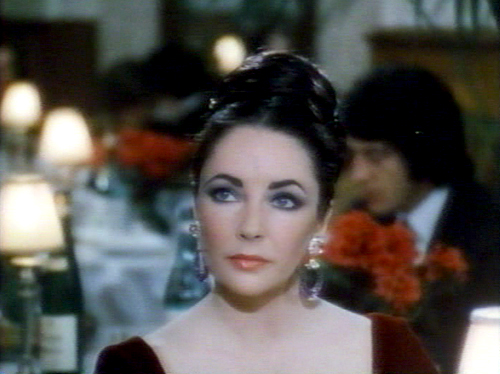
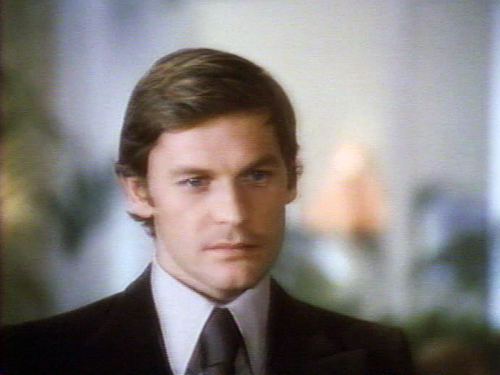
As the film slowly unfolds the audience is supposed
to be surprised by the May-September romance that
blossoms between 41 year-old Elizabeth Taylor and
29 year-old Helmut Berger, but that’s impossible.
Taylor still looked stunning at 41, which only manages
to muddle the plot. And when a ragged looking Henry Fonda
finally shows up as the cold distracted husband who is
having an affair behind Taylor’s back you’re left
wondering, why? There is a great scene where Taylor
confronts Henry Fonda telling him that she only had
plastic surgery in an effort to get him back, but Fonda
isn’t moved. Elizabeth Taylor’s character is forced to
realize that plastic surgery can’t save a marriage that
is emotionally dead.
The only real reason to sit through Ash Wednesday is to
watch lovely Liz and handsome Helmut Berger exchange
passionate glances and loaded words until they finally
fall into bed together. Elizabeth Taylor looks amazing
in the film and waltzes through it wearing some fabulous
Edith Head costumes and impressive Valentino fashions.
Her performance is also rather convincing and low-key
even if the material is completely forgettable.
She could have easily hammed it up, but Taylor obviously
has some emotional connection to the character she’s
playing and her sincerity is believable. On the other hand,
the talented Helmut Berger is wasted here and he seems
more than a little distracted in the film.
Rumor has it that Taylor’s husband Richard Burton thought
Ash Wednesday was incredibly vulgar and he was bothered by
the love scenes Berger shared with Taylor.
Richard Burton was sure that Berger and Taylor were having
an affair off screen as well, even though Helmut Berger was
open about his homosexuality. According to writer
Dominick Dunne who produced Ash Wednesday,
the behind-the-scenes drama happening during the making of
the film was more interesting than anything going on in
front of the cameras. Elizabeth Taylor was chronically late
to the set prompting Paramount Studio head Robert Evans to
fly off the handle and the fights that occurred between
Taylor and Burton were explosive enough to frighten the rest
of the cast and crew.
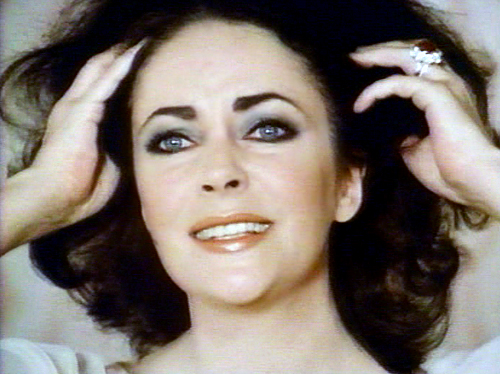
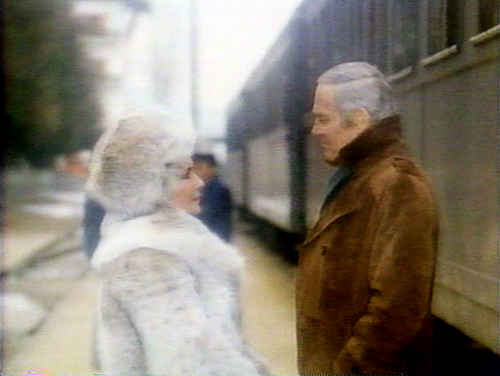
Director Larry Peerce previously had some success directing
episodes of Batman (1966) and The Wild Wild West (1967),
as well as popular films such as Goodbye, Columbus (1969),
but he brings none of the style or humor from his earlier
efforts to Ash Wednesday. The film takes much too long to
get going and there aren’t enough bedroom scenes in it, but
what does occur is a bit steamy so if you happen to love
watching Elizabeth Taylor and Helmut Berger on screen as
much as I do, you might find Ash Wednesday worth a look.
On the other hand, Ash Wednesday is really just a blueprint
for the type of dull and lurid melodrama that you might find
playing on the Lifetime Movie Channel at 1am. And if I didn’t
know any better I’d swear the script was adapted from some
Harlequin romance novel. If that sort of thing holds no appeal
you should avoid this film at all cost.
Ash Wednesday is only available on video and I can’t really
make a case for its DVD release. Many of Elizabeth Taylor’s
adoring fans would probably like to see the film become more
easily available, but for now they’re going to have to pick up
a used copy of the Paramount VHS at Amazon if they want
to see it.
You can find more images from the film in my Ash Wednesday
Flickr Gallery.
RIP Ruslana Korshunova
Supermodel falls to her death
from Manhattan building
June 29, 2008 
In what is being called “an apparent suicide,”
fashion model Ruslana Korshunova fell to her death from a building in Manhattan’s Financial District on Saturday.
Korshunova appeared in the European Vogue magazine as well
as ads for Marc Jacobs, DKNY, and Vera Wang. She was 20 years old.
by Cristina Neri | April 8, 2007
I recently watched Massimo Dallamano’s Dorian Gray for
the third or forth time and I was inspired to write about
the movie. When the opportunity to contribute to Neil’s
Trashy Movie Celebration Blog-a-thon arrived I figured a
review of the film would be the ideal contribution since
it definitely qualifies as a trashy movie - eurotrash to
be exact - and it’s also a personal favorite.
Oscar Wilde’s classic tale of a vain, wealthy and beautiful
youth who’s sins are preserved in a portrait that ages
horribly while he remains young, has been adapted for the
screen many times. But I don’t think any movie except Massimo
Dallamano’s 1970 film has been able to really capture the
decadence of Wilde’s original story. Dallamano set his film
version of Dorian Gray in the present, which at that time was
the height of the sexual revolution in the late sixties.
This gave the director ample opportunity to explore the world
of swingers, uninhibited sex and gender bending through the
eyes of the curious Dorian Gray.
The movie stars the attractive German actor Helmut Berger
who made a name for himself in some of Luchino Visconti’s
best films including The Damned, Ludwig and Conversation Piece,
but he also appeared in many European thrillers and various
other trashy movies such as the notorious Salon Kitty.
The critics have never been too kind to Berger, which is a
shame because when he’s good, he’s very very good and when
he’s bad, he’s still a lot of fun to watch. Helmut Berger
has what so many actors lack today,charisma and screen presence.
Massimo Dallamano couldn’t have picked a better actor to play
the vain and self absorbed Dorian Gray. Helmut Berger is
clearly enjoying himself in the role and it’s easy to believe
that women and men of all ages and sexual persuasions are
attracted to him. Berger’s erotic persona and fluid sexuality
are used to their fullest extent in Dorian Gray and the
audience is easily able to project their own fantasies into
the movie if they’re willing.
The film opens with a shot of Dorian’s blood-stained hands
signaling what’s to come and then we’re immediately taken to
a cabaret where a drag queen is performing as Dorian and his
companions watch. When the drag queen strips down to reveal
sexy black lingerie, you know you’re in for a wild ride.
It’s impossible to watch the opening moments of Dorian Gray
and not be reminded of Helmut Berger’s own drag performance
in Visconti’s The Damned where he impersonated Marlene Dietrich.
The Damned was released a year earlier and Dallamano’s sly
tribute to Helmut Berger’s earlier performance in Visconti’s
film acts as a wonderful introduction to Dorian Gray.
Dorian’s friend Basil Hallward is played by the veteran
British actor Richard Todd. Basil is the artist who paints
Dorian’s doomed portrait and Richard Todd is convincing as
Dorian’s concerned and more mature friend. Thanks to Basil,
Dorian is introduced to the much more conniving and depraved
Henry Wotton who’s brilliantly brought to life by another
veteran British actor, the great Herbert Lom. Henry and the
beautiful Alice (Maria Rohm) introduce Dorian to the underside
of high-society and encourage Dorian’s hedonistic lifestyle.
As the film progresses Dorian meets his first love interest
in the tragic figure of an aspiring Shakespearean actress
named Sybil Vane. Sybil is played by the pretty Swedish actress
Marie Liljedahl who’s mostly remembered for the erotic films
she made including Jess Franco’s Eugenie. In Dorian Gray we’re
asked to believe that Marie Liljedahl is an innocent virgin
seduced by the devilish Dorian and it actually works.
Thankfully Dallamono doesn’t bore us with their courtship.
Dorian and Sybil seem to fall in love at first sight and their
relationship quickly turns sexual. The audience knows they’re
in love because key lines from Shakespeare’s play Romeo & Juliet
are played over and over again in the background as the two lovers
gaze into each other’s eyes and roll around in bed together.
Sybil devotes herself to Dorian, but after he falls in love with
his own portrait, Dorian can really only be faithful to himself.
Under Henry’s influence Dorian seems to forget his feelings for
the naive Sybil and begins to dabble in the decadent lifestyle
that will soon destroy him.
At first Dorian’s passions are rather mild, and include occasional
make-out sessions with wealthy socialites, as well as fancy parties
with expensive foods and lots of booze. Sybil doesn’t appreciate
Dorian’s upper-class friends or approve of their lifestyle, and
her jealousy turns to delirium when she notices other women
flirting with Dorian.
After Sybil suddenly kills herself in an act of desperate passion,
Dorian succumbs to his most depraved desires. He claims that he
feels nothing after Sybil’s death, but Dorian seems to want to
bury his grief in random sexual encounters, yacht parties and
go-go clubs. He visits bath houses with Herbert Lom, cruises
the docks for sailors and seduces a wealthy elderly lady in a
horse barn. The Dorian in Massimo Dallamano’s movie has no
inhibitions and we get to enjoy his decadent adventures as
they’re exposed.
There’s an unusual voyeuristic element added to the film
after Dallamano introduces a pretty female photographer
into the story. The photographer starts following Dorian
around and snapping photographs of him whenever she can.
She seems to become Dorian’s constant companion and helps
him blackmail his friend Alan (Renato Romano) by snapping
photos of Alan’s lovely wife (Margaret Lee) and Dorian
together in bed.
As you may have noticed by now, many of the actors in
Dallamano’s film are regulars in Jess Franco’s movies.
I’ve read that Franco was originally supposed to direct
Dorian Gray before Massimo Dallamano took over so it’s not
surprising that the movie’s cast resembles the cast of
a Franco film. It would have been interesting to see what
Franco could have done with the story and the cast, but
Dallamano’s a skilled director, writer and cinematographer
and his talents are on full display in Dorian Gray
Dallamano’s film is fairly faithful to Wilde’s original
story and where previous film adaptations rarely suggested
any of the sexual decadence that Wilde could only hint at
in his book, Dallamano’s movie revels in it. Critics have
called the film trashy and lifeless. The movie is undoubtedly
trashy, but it’s anything but lifeless, especially when it’s
compared to other film adaptations of Oscar Wilde’s
original story
Oscar Wilde was part of the Aesthetic Movement in British
literature, which developed the “cult of beauty” and believed
that the arts should offer cultivated sensual pleasures instead
of morality and sentimentality. The British Aesthetic movement
stressed the importance of symbolism and suggestion rather than
statement. Intentional or not, Dallamano’s film follows an
aesthetic that would have made Wilde proud. The movie celebrates
the fashions, decadent lifestyles and sexual freedoms of
the times that it was made in with lots of style and very
little sentimentality. The beautiful Dorian and the sensual
pleasures he indulges in are captured with an unflinching eye
and no concern for morality.
Of course in some ways Wilde’s Dorian Gray was a statement
against everything the Aesthetic Movement stood for.
The story of Dorian Gray celebrates decadence just as it
criticizes its indulgences. As Dorian’s eventual end
approaches he is forced to pay for his sins, but the joy
of traveling with Dorian on his hedonistic journey is not
lost in Massimo Dallamano’s film as it is in so many other
movie adaptations.
One of the most interesting things Dallamano does with
Dorian is to wrap him in Zebra fur. Dorian has zebra drapes
on his windows and zebra fur rugs on his floors. By the end
of the film Dorian is dressed in a floor length zebra fur
coat that would make many pimps in 1970 envious.
Zebras each have a unique stripe pattern that is similar
to a persons fingerprint and a zebra often represents
individuality. In occult symbolism a zebra can even suggest
knowledge both seen and unseen, and their stripped patterns
of black on white or white on black can suggest that what
you see is not always what you get. When the zebra appears
in your dreams it can even indicate a time of change or
represent hidden knowledge that is about to be revealed.
I have no idea if the director had anything in mind when
he draped Dorian’s body and decorated his home in zebra fur,
but I think it’s fascinating to explore what this possible
symbolic gesture might suggest.
Finally, I can’t talk about Dallamano’s movie without
mentioning the exceptionally groovy score by composer
Giuseppe De Luca (A.K.A. Peppino De Luca).
It adds many layers to the film and it also celebrates
the movies most decadent moments with lots of rhythmic flair.
Unfortunately the film is only available on VHS at the moment
and the quality of the prints that are available are rather
awful. Hopefully a DVD company like Blue Underground or
Mondo Macabro will rescue Massimo Dallamano’s Dorian Gray
and restore it to it’s original splendor. The movie really
deserves another look and I think critics will be able to
appreciate its eurotrash charms now that over 35 years have
passed since it’s original release.
by Cristina Neri | March 22, 2007

David Zuzelo who runs the terrific blog Tomb it
May Concern started what he refers to as The Eurotrash
Pinnacle Project. It’s an effort to bring together a list
of favorite Eurotrash films from every genre imaginable
including eurohorror, giallo, eurospy and spaghetti westerns.
I recently contributed my own list of Top 10 Eurotrash films
with an additional 10 titles tacked on the end for good
measure, since selecting only 10 was an impossible task.
In my brief commentary for the first 10 films I listed,
I used the word “sexy” a lot, which isn’t too surprising
since sex often plays an important part in Eurotrash films
and some of my favorite actors (Klaus Kinski, Alain Delon,
Terence Stamp, Helmut Berger and John Phillip Law) often
show up looking very sexy in the movies I mentioned.
You can find my list of favorite Eurotrash films now posted
over at Tomb it May Concern. Be sure to click on the label
link “Eurotrash Film Pinnacle Project” at the bottom of the
entry because it will take you to the the rest of the great
movie lists contributed by others.
| 


